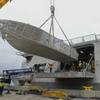The built-for-purpose National Security Multi-Mission Vessel (NSMV) training ship comes to life.
Anybody who has spent four years at a State Maritime Academy (SMA) has also spent time at sea on a Marad-owned training vessel. Today, these platforms are long in the tooth, equipped with outdated equipment and not necessarily conducive to the task of training cadets for a future career at sea. For a long time, though, they’ve gotten the job done.
It is also true that some of these hulls are one equipment casualty away from the bone yard, despite that best efforts of the schools tasked with their upkeep. That’s got SMA officials worried. The Massachusetts Maritime Academy’s Academic Dean Brad Lima knows what is at stake. “Kennedy is 50 years old and sound mechanically. We are installing an ultra low sulfur fuel system to be environmentally compliant. We hope that T/S Kennedy has many good years of sailing left in her.”
That’s good news, if true. The vessels are owned by Marad and as such, serve myriad other functions. Over time, they’ve been called up and activated during national emergencies – notably in the aftermath of hurricanes Sandy and Katrina and this year’s particularly robust hurricane season. Leveraging that reality, state maritime academy stakeholders are making their most logical pitch ever: a built-for-purpose class of training ships. In a perfect world, they’re hoping for as many as five, which could come at a series-build price of $1 billion. Attempted before, and with predictable results, the stars may finally be aligned to get something done. Before that can happen, the coalition has to convince legislators that the price tag will yield good value to federal taxpayers.
In December, Massachusetts Maritime Academy President Fran McDonald weighed in with Marine News. “While the training of cadets is the primary mission of these ‘on-loan’ training ships, these well-maintained vessels serve an important corollary role in support of national disaster response or military need. This role was clearly displayed this past fall as three of the six ships were activated in support of Hurricanes Harvey and Maria and a fourth was notified of a possible activation in support of the California wild fires.”
These kinds of testimonials are expected, coming from schools that desperately need ships. Separately, however, FEMA Emergency Management specialist Dan Kelleher had a birds-eye view as the recent post-hurricane crisis in Puerto Rico unfolded. “The T/S Kennedy was on site in San Juan with FEMA personnel and commodities, before SJU [airport] was reopened to commercial air-traffic. The ship took on cargo and FEMA staff in Ingleside, Texas and departed for Puerto Rico. When we arrived in San Juan, the only other ship in the bay was a U.S. Coast Guard cutter. We were the tip of the spear,” he said, adding quickly, “These ships provided thousands of responders a safe and secure place to live and sleep; hot meals and showers and most importantly clean drinking water. The academy ships are a phenomenal asset to the federal government.”
At the California Maritime Academy, CMA President Tom Cropper gave a similarly ominous account. He told Marine News, “The CMA ship hasn’t been used in five years but Marad did call to see if FEMA could use it for dorms for firefighters in the recent SoCal fires. It turns out that it wasn’t needed.” That kind of scenario, he says, makes the training vessels that much more important. “West Coast fires – unlike East Coast hurricanes – aren’t predictable. That makes a ship like the NSMV all the more valuable.”
A Plan Emerges
Herbert Engineering (HEC) was contracted to prepare the
NSMV design, and in 2015 a concept level design was prepared, with the Phase 3 design completed in early 2017. That package is expected to be sufficient for shipyards to prepare bids to build NSMV’s. The goal is to deliver new vessels to all five SMA’s. These hulls need to be useful assets for government response to humanitarian and disaster crises in coastal and port areas. This ability to merge two primary missions – training and disaster response – into one vessel is a critical design feature that must be incorporated into the new training ships.
Key design features include safety (compliant to SOLAS, USCG and ABS class rules), a capacity of 760 persons, and an operating draft of no more than 25 feet. This will allow access to less developed ports in support of future relief missions.
A hull lines optimization was effective in reducing required propulsion power by about 10 percent between the concept design and the optimized hull design. Two separate engine rooms were built into the design for reasons of redundancy in an emergency and to allow training to take place in one engine room while the second is used for propulsion.
In Extremis: All Options on the Table
CMA’s President Cropper grimly summed up the looming crisis. “We’re in extremis now. People want to know, ‘What’s plan B?’ We’re in ‘plan B’ now. Maine’s ship needs a serious engine overhaul. Texas has no ship and Mass and New York’s ships are quite old. People say it will cost a lot of money. Well, it will require that kind of investment.”
As the academies and Marad battle for the funds to build the NSMV, other options have emerged. One solution involves having more than one academy leverage one hull for training purposes. It has been done before, but in practice greatly accelerates the wear and tear on these aging vessels. This option merely moves the timeline forward as to when the real crisis will occur.
Still another option is being tossed around. Sales of second-hand ships reached a 10-year high in 2017 on optimism that one of the shipping industry’s deepest recessions was nearing an end.’ More than 1,600 ships worth $19 billion were sold, the highest number since 2007. Fueled by growing confidence, shippers are taking advantage of low prices.
The right commercial hull of recent vintage, repurposed for Marad’s training needs, might just be the ticket. That’s because the average price of a five-year old 180,000 DWT bulker is now just $33 million, up from the $24 million low of 2016, but much less than the steep estimated price of $250 million for just one NSMV.
SUNY President Dr. Michael Alfutis disagrees. The most cost effective option – the NSMV – will support U.S. shipbuilding, provide domestic mariners with the necessary credentials to support U.S. military sealift, and at the same time, increase the nation’s ability to respond to national disasters. “In fact, it is the only option that meets all three,” he said.
Newly sworn-in Marad Chief
Mark Buzby, for his part, says, “We can’t use the model that we’ve used in the past. We have to approach this in a much different way. Building the purpose-built ship would be the ultimate way to do it if we were really serious. But thus far, we have not done that. So the fall back – if we don’t build a purpose-built ship – is to go on the market, and it’s going to have to be a foreign-built, existing used ship because, because there aren’t any in the US inventory that could fulfill that. Buying a foreign ship and modifying it in a domestic yard – we’re doing that homework now. We have to look at it.”
Standardization: Better Training, and Economy, too
There is also a lot to be said for a standardized training platform, especially if congress approves the series-build option. Both training and maintenance can be standardized across hulls, something that would create ultimately reduce costs and additionally allow the SMA’s to develop a standardized, logical curriculum that’s not necessarily possible today. A fit-for-purpose/series-built vessel comes at a higher upfront cost than a used hull, but yields a much lower ‘total ownership cost.’ That’s because standardized, off-the-shelf fittings across the fleet can be acquired more cheaply.
CMA’s Cropper agrees. “CMA has one of the younger vessels at about 28 years old – it is a diesel ship, but the almost 30 year old hull houses 40 year old equipment and technology.” Hence, the NSMV would also bring relevant training back to the academies. “Relevant training from day one prepares mariners for real life. You can’t do that on a tired 40 year old hull,” insists Cropper.
Manning Crisis Looming
The U.S. Maritime Administration has officially sounded the alarm. Buzby points to the coming manning crisis as the rallying cry for the NSMV. Buzby says that would be a mistake. And, the first place to address those worries is at the six SMA’s. Buzby, a Kings Point graduate, says that we need all of them to thrive.
“We absolutely do. We [also] need them coming out of Kings Point and we need them coming out of the other six schools,” he said, adding quickly, “This adds a level of concern and crisis to the whole school ship issue, because if we lose the school ship, that’s a big chunk of people that I lose. It’s all connected.”
Asked if he thought that the newly designed National Security Maritime Vessel (NSMV) class could get funded and built, he pointed to financing options that might work if traditional funding did not. “If we’re looking to get regular construction money out of the Navy or out of Congress to the tune of 320 million dollars, we may have to get that incrementally, or we may not be able to get that at all, in which case we may have to look at maybe a build-lease kind of option. We’ve done that before. We built the first pre-positioning ships that way.”
In one of the first definitive statements about the issue to date, Buzby all but promised that he would get the ships. “We’re looking at multiple options of how to make this work, but the key to it is we know we have to replace school ships. Absolutely, we have to.”
Mass. Maritime’s Fran McDonald perhaps says it best when he offers, “The partnership between the Maritime Administration, the State Maritime Academies and the cadets who pay tuition to attend the state academies is the consummate federal/state/citizen partnership. In order for our nation to maintain a robust strategic sea-lift capability and recognizing the critical role that civilian mariners play in support of that sealift effort, the shared responsibility between these three parties stands as a best practice that, arguably, should be modeled elsewhere in government.”
Indeed, and in the administration building of the Massachusetts Maritime Academy, there is a plaque that commemorates the words of the nation’s first Maritime Administrator, Joseph P. Kennedy. First year MMA cadets are required to memorize it. It reads simply, “You can have a Merchant Marine with first class men even if they sail second class ships, but second class men can’t be trusted with the finest ships afloat.” Without a working plan to replace the current fleet of SMA training ships, we very soon won’t have the men, women or the ships to make Joe Kennedy’s thesis matter.
The Proposed NSMV at a glance …
- LOA: 159.85 m (524.5 ft.)
- Beam: 27 m (88.6 ft.)
- Draft: 6.5 m (21.4 ft.)
- Service Speed: 18 knots
- Cruising Speed: 12 knots
- Propulsion: Diesel Electric
- Propulsion engines: 4 x Diesel Generators
- Fuel Consumption: 26 tpd at 12 knots
- Propellers: 1 propeller, fixed pitch
- Crane: 1 x Jib Boom w/35 MT SWL
- RoRo ramp: 20 ft. wide/40 ton capacity
- Capacity: 10 x 40 ft trailers with 26 autos
- Total Power: 15,680 kW
- Fuel: MGO) <0.1% Sulfur
- Thrusters: Bow & Stern
- Endurance: ~ 11,000 nm
- RoRo deck: 10,700 sq. ft.
- TEU Capacity: ~ 64 TEU
(As published in the January 2018 edition of
Marine News)










